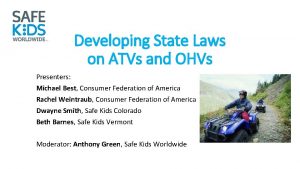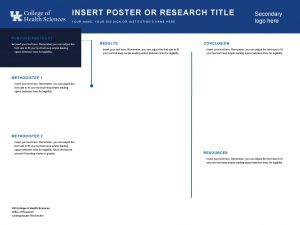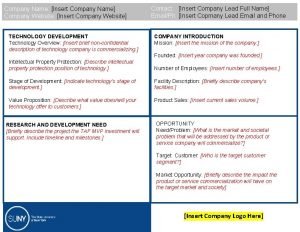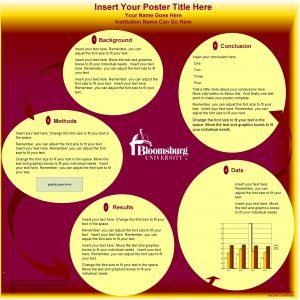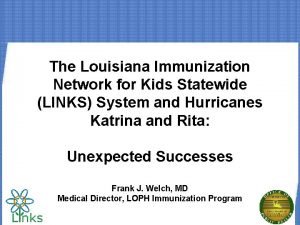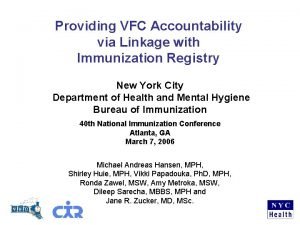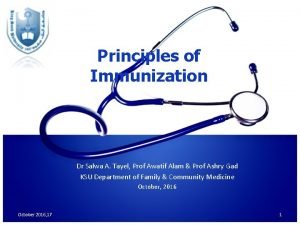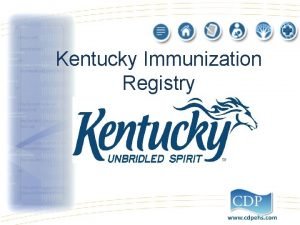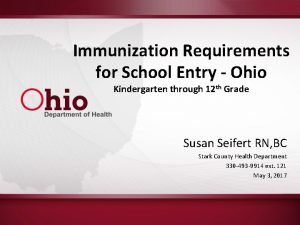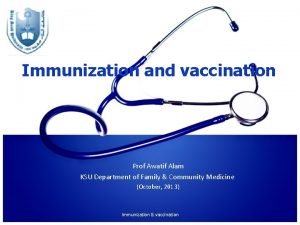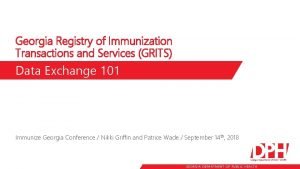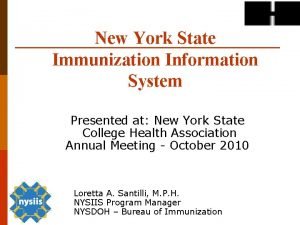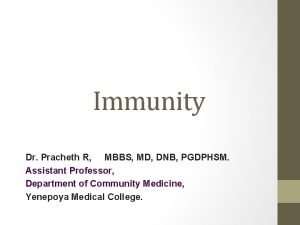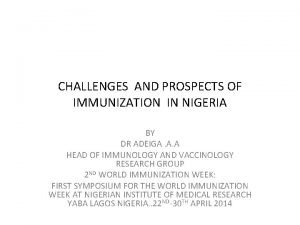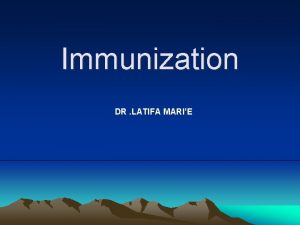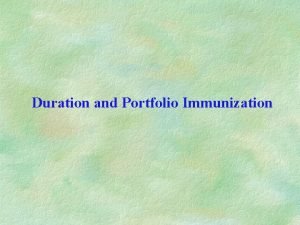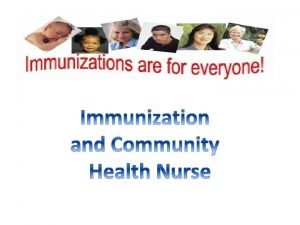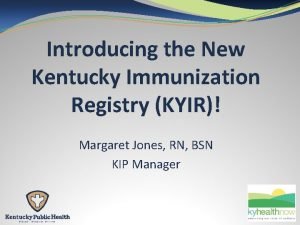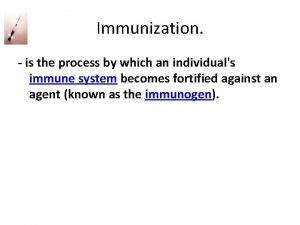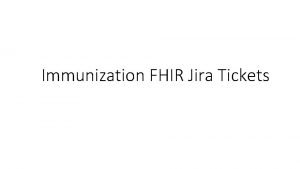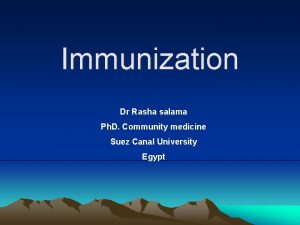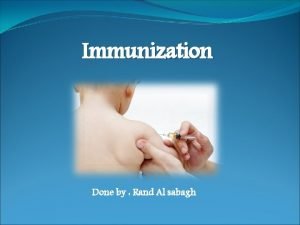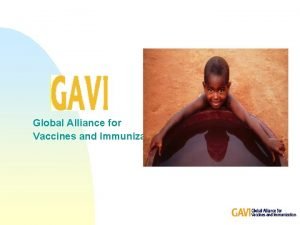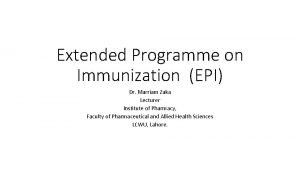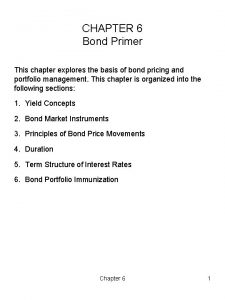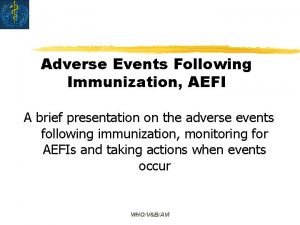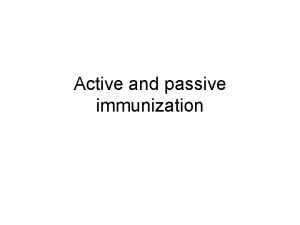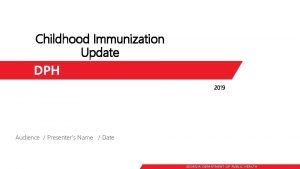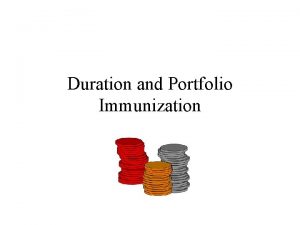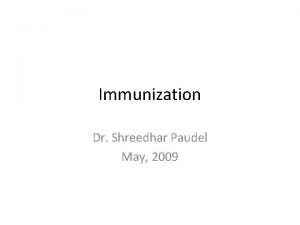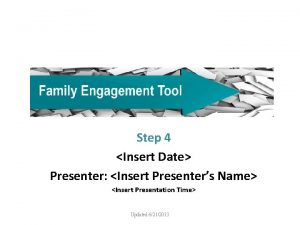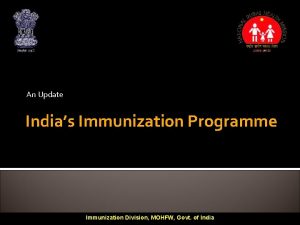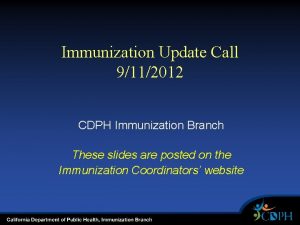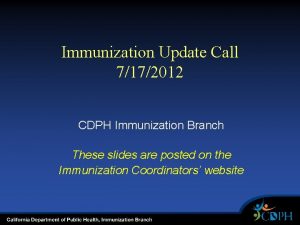Childhood Immunization Update INSERT NAME OF PRESENTERS INSERT
![Childhood Immunization Update [INSERT NAME OF PRESENTERS] [INSERT YOUR ORGANIZATIONAL LOGO] Last updated March Childhood Immunization Update [INSERT NAME OF PRESENTERS] [INSERT YOUR ORGANIZATIONAL LOGO] Last updated March](https://slidetodoc.com/presentation_image/13eb824db808558fc21570c4523c3f9c/image-1.jpg)




















































![Questions? [ADD YOUR CONTACT INFORMATION HERE] Questions? [ADD YOUR CONTACT INFORMATION HERE]](https://slidetodoc.com/presentation_image/13eb824db808558fc21570c4523c3f9c/image-54.jpg)
- Slides: 54
![Childhood Immunization Update INSERT NAME OF PRESENTERS INSERT YOUR ORGANIZATIONAL LOGO Last updated March Childhood Immunization Update [INSERT NAME OF PRESENTERS] [INSERT YOUR ORGANIZATIONAL LOGO] Last updated March](https://slidetodoc.com/presentation_image/13eb824db808558fc21570c4523c3f9c/image-1.jpg)
Childhood Immunization Update [INSERT NAME OF PRESENTERS] [INSERT YOUR ORGANIZATIONAL LOGO] Last updated March 2019

Instructions for Presenters § Be sure to customize the title slide, the state/local resources slide and the contact information slide. § This slide deck should be adjusted to fit your allotted time and personal style of presenting. § Rather than deleting slides to shorten the presentation, simply hide the slides you do not want to show. § Replace the content on this slide with your disclosures statement. 2

Learning Objectives By the end of this session, you should be able to: § Cite current immunization coverage rates for young children and teens § Describe current challenges related to childhood immunization § Describe key research findings regarding parental attitudes, beliefs, and practices § Describe effective strategies for talking with parents about vaccines § Access CDC training and communication resources 3

Immunization Successes

Number of Diseases Prevented by Vaccines Included in the Routine Child/Adolescent Immunization Schedule 1964 (6) Smallpox Polio Diphtheria Pertussis Tetanus Measles 1985 (7) Polio Diphtheria Pertussis Tetanus Measles Rubella Mumps 1995 (10) 2019 (16) Polio. Hep. B Diphtheria Hep. A Pertussis Varicella Tetanus Pertussis Chickenpox Tetanus Pneumococcal Measles Influenza Rubella Meningococcal Measles Influenza Mumps Rubella Mumps. Rubella Rotavirus Hib Meningococcal HPV Hep. B Hib (infant) Mumps Rotavirus Varicella Hib HPV 5

Impact of Vaccines in the 20 th and 21 st Centuries Disease 20 th Century Annual Morbidity† 2017 Reported Cases † † Percent Decrease Smallpox 29, 005 0 100% Diphtheria 21, 053 0 100% Measles 530, 217 120 > 99% Mumps 162, 344 6, 109 96% Pertussis 200, 752 18, 975 91% Polio (paralytic) 16, 316 0 100% Rubella 47, 745 7 > 99% Congenital Rubella Syndrome 152 5 97% Tetanus 580 33 94% 20, 000 33* > 99% Haemophilus influenzae † JAMA. 2007; 298(18): 2155 -2163 † † CDC. Epidemiology and Prevention of Vaccine-Preventable Diseases (Pink Book). Appendix E. * Haemophilus influenzae type b (Hib) < 5 years of age. An additional 10 cases of Hib are estimated to have occurred among the 203 reports of Haemophilus influenzae (< 5 years of 6 age) with unknown serotype.

Protecting Children from Serious Disease through 1 st and 2 nd Generation Pneumococcal Conjugate Vaccines (PCV) Source: Pneumococcal Disease Surveillance and Reporting. https: //www. cdc. gov/pneumococcal/surveillance. html 7

Vaccination Coverage Among Children 19 -35 Months National Immunization Survey-Child, 2011 -2017 3+ Hep. B 95 3+ Polio 1+ MMR 90 1+ Var 4+ DTa. P 4+ PCV Percent Vaccinated 85 Hib-FS* 80 Hep. B birth 75 Rotavirus § dose † 70 4: 3: 1: 3*: 3: 1: 4 ¶ 65 60 2+ Hep. A 55 50 2011 2012 2013 2014 Survey Year 2015 2016 ≥ 3 or ≥ 4 doses of Haemophilus influenzae type B vaccine, depending on vaccine type. Hepatitis B dose administered from birth through age 3 days. § ≥ 2 or ≥ 3 doses of Rotavirus vaccine, depending on product type (≥ 2 doses for Rotarix or ≥ 3 doses for Rota. Teq). ¶ The combination includes ≥ 4 DTa. P, ≥ 3 polio, ≥ 1 MMR, ≥ 3 or ≥ 4 doses Hib, depending on vaccine type, ≥ 3 Hep. B, ≥ 1 varicella, and ≥ 4 PCV. 2017 * † 8

Very Few U. S. Toddlers Have Received No Vaccines HP 2020 Goal: <1% 1. 0% 0. 6% 2008 2009 0. 7% 1. 3% 0. 8% 2011 2012 0. 7% 0. 8% 2014 2015 2016 0. 0% SOURCE: CDC National Immunization Surveys 2010 2013 2017 9

The Impact of Childhood Immunization CDC estimates that among children born 1994 -2018, vaccines will prevent an estimated: • 419 million illnesses • 26. 8 million hospitalizations • 936, 000 early deaths over the course of their lifetimes At a net savings of: • $406 billion in direct costs • $1. 9 trillion in total society costs Updated data from previous article: Benefits from Immunization During the Vaccines for Children Program Era – United States, 1994 -2013. MMWR. 25 April 2014 10

Adolescent Vaccination Coverage 2006 -2017 FIGURE. Estimated coverage with selected vaccines and doses* among adolescents aged 13– 17 years, by survey year and ACIP recommendations† — National Immunization Survey-Teen, United States, 2006– 2017§ 100. 0 Revised Adequate Provider Data definition 90. 0 80. 0 Percentage Vaccinated 70. 0 ≥ 1 Tdap 60. 0 ≥ 1 Men. ACWY ACIP recommendation 2016– 2017 50. 0 ≥ 2 Men. ACWY ≥ 1 HPV 40. 0 ≥ 3 HPV 30. 0 ACIP recommendation 2011– 2015 HPV UTD 20. 0 10. 0 2006 2007 2008 2009 2010 2011 Year 2012 2013 2014 2015 2016 2017 Abbreviations: ACIP = Advisory Committee on Immunization Practices; HPV = human papillomavirus; Men. ACWY = quadrivalent meningococcal conjugate vaccine; Tdap = tetanus toxoid, reduced diphtheria toxoid, and acellular pertussis vaccine; UTD = up to date. * ≥ 1 dose Tdap at or after age 10 years; ≥ 1 dose Men. ACWY or meningococcal-unknown type vaccine; ≥ 2 doses Men. ACWY or meningococcal-unknown type vaccine, calculated only among adolescents aged 17 years at time of interview. Does not include adolescents who received their first and only dose of Men. ACWY at or after 16 years of age; HPV vaccine, nine-valent (9 v. HPV), quadrivalent (4 v. HPV), or bivalent (2 v. HPV). The routine ACIP recommendation for HPV vaccination was made for females in 2006 and for males in 2011. Because HPV vaccination was not recommended for males until 2011, coverage for all adolescents was not measured before that year; HPV UTD includes those with ≥ 3 doses and those with 2 doses when the first HPV vaccine dose was initiated before age 15 years and at least 5 months minus 4 days elapsed between the first and second dose. † ACIP revised the recommended HPV vaccination schedule in late 2016. The recommendation changed from a 3 -dose to 2 -dose series with appropriate spacing between receipt of the first and second dose for immunocompetent adolescents initiating the series before the 15 th birthday. Three doses are still recommended for adolescents initiating the series between the ages of 15 and 26 years. Because of the change in recommendation, the graph includes estimates for ≥ 3 doses HPV from 2011 to 2015 and the HPV UTD estimate for 2016 and 2017. Because HPV vaccination was recommended for boys in 2011, coverage for all adolescents was not measured before that year. § NIS-Teen implemented a revised adequate provider data definition (APD) in 2014, and retrospectively applied the revised APD definition to 2013 data. Estimates using different APD definitions may not be directly comparable. 11

HPV vaccination is the best way to protect children from cancers caused by HPV *National, Regional, State, and Selected Local Area Vaccination Coverage Among Adolescents Aged 13– 17 Years — United States, 2017. MMWR Morb Mortal Wkly Rep 2018; 67: 909– 917. 12

Immunization Challenges

Childhood Immunization Disparities In spite of high national childhood immunization coverage rates: § We see lower coverage for some vaccines requiring doses in the second year of life, such as DTa. P, Hib, and PCV. § For most vaccines, coverage among children living below the federal poverty level is lower than coverage among those living at or above the federal poverty level. § Coverage is lower among children on Medicaid and much lower among uninsured children. § CDC is currently working to identify reasons for disparities and evidencebased interventions. Vaccination Coverage Among Children Aged 19– 35 Months — United States, 2016. MMWR Weekly / November 3, 2017 / 66(43); 1171– 1177 14

Recent Disease Outbreaks

Measles Cases Reported in the U. S. § Although year-round transmission has been eliminated from the U. S. , measles cases are still reported in the U. S. , including among adults. - Most cases importation-related § Measles is still common in many parts of the world including some countries in Europe, Asia, the Pacific, and Africa. § The majority of people who got measles were unvaccinated. Measles Cases and Outbreaks. https: //www. cdc. gov/measles/cases-outbreaks. html Morbidity and Mortality Weekly Report (MMWR), Notifiable Diseases and Mortality Tables. https: //www. cdc. gov/mmwr/publications/index. html Number of Measles Cases by Year 2010 2011 2012 Cases 63 220 55 2013 2014 2015 2016 2017 2018 2019 187 667 188 86 120 372* 228** *As of December 29, 2018 **As of March 7, 2019 16

Measles, U. S. 2017 and 2018 § 2017: 120 measles cases reported in 15 states and D. C. - 7 outbreaks were reported (defined as 3 or more linked cases) - 85% of cases in 2017 were outbreak-related § 2018: provisional 372 measles cases reported in 25 states and D. C. - Second-greatest number of cases since measles was eliminated in 2000 - 17 outbreaks were reported ( defined as 3 or more linked cases) - 83% of cases reported were outbreakrelated *Preliminary data reported to CDC’s National Center for Immunization and Respiratory Diseases, updated monthly. 17

Mumps Cases Reported in the U. S. § 2017: 6, 109 mumps cases reported in 48 states and D. C. § 2018: provisional 2, 251 cases reported in 47 states and D. C. *Preliminary data reported to CDC’s National Center for Immunization and Respiratory Diseases, updated monthly. Mumps outbreaks are not reportable. Mumps Cases and Outbreaks. https: //www. cdc. gov/mumps/outbreaks. html Morbidity and Mortality Weekly Report (MMWR), Notifiable Diseases and Mortality Tables. https: //www. cdc. gov/mmwr/publications/index. html Number of Mumps Cases by Year Cases 2010 2, 612 2011 404 2012 229 2013 584 2014 1, 223 2015 1, 329 2016 6, 366 2017 5, 629 2018 2, 251* *-As of February 24, 2018 2019 151** **As of February 28, 2019 18

160000 140000 90 80 1 st Dose 120000 2 nd Dose 100000 1977 1 st Dose ACIP Recommendation 80000 70 60 1989 Dose MMR ACIP Recommendation 2 nd 50 40000 40 2006 Midwest 2009 2016 Arkansas 30 Northeast 20000 10 60000 MMR vaccine coverage Reported Mumps Cases, United States, Vaccine Era, 1968 -2017 20 0 0 '68 1968 -1982 Vaccine Implementation 1983 -1992 Resurgence Source: National Notifiable Diseases Surveillance System (cases, passive surveillance); National Immunization Survey (NIS) (1 st dose coverage 1935 year olds), National Health Interview Survey & NIS-Teen (2 nd dose coverage); 2017 case data is preliminary and subject to 4 change 19

2018 Reported Mumps Cases (n=2, 251) Source: CDC Morbidity and Mortality Weekly Report (MMWR), Notifiable Diseases and Mortality Tables 20

Mumps Summary § Use of the mumps vaccine reduced disease levels ~99% versus pre-vaccine era in the United States § Since 2006, multiple mumps outbreaks have occurred in populations highly vaccinated with 2 doses of MMR vaccine - From January 2016–June 2017, health departments reported 150 mumps outbreaks, (e. g. , in households, schools, universities, sports teams, church groups, workplaces, and large parties) § Intense exposure settings and waning immunity appear to be risk factors for secondary vaccine failure § Current 2 -dose schedule is sufficient for mumps control in the general population § At the October 2017 meeting, ACIP recommended a 3 rd dose of MMR vaccine* for persons at increased risk for mumps during an outbreak *MMRV vaccine may also be used for children aged ≤ 12 years 21

Pertussis Cases Reported in the U. S. § Pertussis cases have steadily increased in recent decades § More than 20, 000 cases per year in recent years § For U. S. infants under 1 year old*: – 1, 683 cases in 2018 – 4 deaths in 2018 *Provisional data Sources: https: //www. cdc. gov/pertussis/surv-reporting/cases-by-year. html https: //www. cdc. gov/pertussis/downloads/pertuss-surv-report-2018 -508. pdf Number of Pertussis Cases by Year 2012 2013 2014 Cases 48, 277 28, 639 32, 971 2015 2016 2017 2018 20, 762 17, 972 18, 975 13, 439* 22

Pertussis Incidence from 1990 -2017 23

Pertussis Summary § Pertussis incidence has increased since 1980 s § Resurgence of childhood disease despite high DTa. P coverage - Young infants at risk - Excellent initial vaccine effectiveness (98%) - Moderate and immediate waning of immunity • 70% effective 5 years after receiving the 5 th dose § Re-emergence of adolescent disease - Tdap effectiveness 73% within 1 year of vaccination; 34% 2 to 4 years post vaccination - Tdap boost in DTa. P recipients may wane more quickly 2 § Switch to acellular pertussis vaccines is changing epidemiology - Waning immunity driving disease incidence Sources: 1 Acosta AM, De. Bolt C, Tasslimi A, Lewis M, Steward LK, Misegades LK, et al. Tdap vaccine effectiveness in adolescents during the 2012 Washington state pertussis epidemic. Pediatrics. 2015; 135: 981– 9. 2 CDC. MMWR 2012; 61(28); 517 -522. 24

Challenges in Normalizing HPV Vaccination and Raising Rates

Barriers to On-Time HPV Vaccination for all Preteens Parents Healthcare Professionals § Not receiving a healthcare professional’s strong recommendation for the HPV vaccine § Perceive parents’ attitudes are negative about HPV vaccine and think they have concerns § Need more information about the HPV vaccine § Knowledge gaps when it comes to talking about HPV vaccine § May believe that their child is too young to get vaccinated for HPV § May have concerns about vaccine adverse effects, safety, and newness § Cost of the HPV vaccine § Inadequate insurance coverage and reimbursement § May prefer to wait and vaccinate older vs younger adolescents § Preference for vaccinating girls vs boys Source: M Holman, Dawn & Benard, Vicki & Roland, Katherine & Watson, Meg & Liddon, Nicole & Stokley, Shannon. (2013). Barriers to Human Papillomavirus Vaccination Among US Adolescents. JAMA pediatrics. 168(1)76 -28. doi: 10. 1001/jamapediatrics. 2013. 2752. 26

Value Parents Place on the Vaccines Median Values Parent 10 9 8 7 6 5 4 3 2 1 0 9. 4 Meningitis 9. 5 Hepatitis Source: Adapted from Healy et al. Vaccine. 2014; 32: 579 -584. 9. 5 Pertussis 9. 3 Influenza 9. 3 HPV 9. 2 Adolescent Vaccines 27

Median Values Clinicians underestimate the value parents place on HPV vaccine 10 9 8 7 6 5 4 3 2 1 0 9. 4 9. 2 Clinician's estimate 9. 5 9. 2 Parent 9. 5 9. 3 9. 2 7. 8 7. 0 5. 2 Meningitis Hepatitis Source: Adapted from Healy et al. Vaccine. 2014; 32: 579 -584. Pertussis Influenza HPV Adolescent vaccines 28

Research to Practice

Understanding Vaccine Knowledge, Attitudes and Beliefs § CDC conducts formative and evaluation research with parents and healthcare professionals in order to inform its childhood and adolescent immunization education campaigns. § This research helps CDC to better understand audience’s knowledge of diseases and vaccines. It also helps CDC to track attitudes, beliefs and self-reported practices over time. 30

CDC Longitudinal Survey of First Time Expectant Moms § Initial survey showed that over 85% of respondents had already made a plan for vaccinating their baby by their 2 nd trimester. § However, only 6% of women were very satisfied with their current level of knowledge about childhood vaccines. § Internet search engines were their #1 source of information about childhood vaccines. Only 22. 5% cited their ob-gyn or primary care provider. § Results suggest a need for midwives and ob-gyns to direct expectant women to credible sources of childhood immunization information. Source: Weiner, J. et al. Childhood Immunizations: First Time Expectant Mothers’ Knowledge, Intentions, Beliefs, and Behaviors. Am J Prev Med 2015; 49(6 S 4): S 426–S 434. 31

Parents’ Vaccination Plans for Youngest Child § CDC-sponsored online survey of 2, 500 parents of children under the age of 7. § 75% reported that they decided on their approach to vaccines before their child was born (63% before pregnancy and 12% during pregnancy) § 89% reported that their child received all vaccines at the time they were recommended § 15% reported that, in general, they are somewhat or very hesitant about childhood vaccines § 8% reported not vaccinating according to the recommended schedule § 13% reported that they plan to delay at least one vaccine in the future § Most common vaccines were: HPV, flu, varicella, MMR, and Hepatitis B Source: CDC National Poll of Parents 2018 32

Parents of Young Children: Three Most Trusted Sources of Vaccine Information 2018 (N = 2, 506) Percent 1 Doctor or HCP 93% 2 Scientific or medical journal 41% 3 Family members 38% 4 Prenatal care provider 36% 5 Internet or social media 18% 6 Friends 10% 7 Books 9% 8 Magazines, newspapers, radio, TV 4% Source: CDC National Poll of Parents 2018 (unpublished data) 33

Parents of Young Children: Vaccine Questions and Concerns Weighted Frequencies 2018 (N = 2, 506) Long-term side effects from shots 31. 7% Short-term side effects from shots (e. g. , fever, redness, etc. ) 25. 5% What ingredients are in vaccines 22. 8% Whether vaccine ingredients are safe 24. 0% The risks of combining vaccines together into one shot 22. 9% Whethere are too many vaccines/whether vaccines overwhelm the immune system 20. 6% Whether vaccines cause chronic disease (asthma, arthritis, etc. ) 20. 8% Whether vaccines are safe 19. 5% Concerns about thimerosal, aluminum, mercury, etc 18. 9% How vaccines are tested 18. 1% Whether vaccines cause autism 17. 9% How you can minimize side effects 16. 6% Whethere are too many vaccines too soon in life 15. 8% Whether diseases are still a threat and are dangerous 13. 0% Source: CDC National Poll of Parents 2018 (unpublished data) 34

Reasons for Not Vaccinating Adolescents with HPV Vaccine, Unvaccinated Adolescents* Aged 13 -17 Years, NIS-Teen, United States, 2017 Parents of Girls Parents of Boys % (95% CI) Safety concerns/ side effects 24. 5 (21. 6 -27. 8) Not needed/necessary 14. 5 (11. 8 -17. 8) Not recommended Lack of knowledge Not sexually active Safety concerns/ side effects 16. 8 (14. 5 -19. 4) 15. 2 (12. 6 -18. 2) 7. 6 (5. 9 -9. 7) Not needed/necessary 14. 2 (12. 0 -16. 7) 7. 5 (5. 7 -9. 6) Lack of knowledge 9. 2 (7. 3 -11. 5) 7. 3 (5. 7 -9. 4) Not sexually active 7. 7 (5. 7 -10. 2) *Analysis limited to adolescents with zero HPV vaccine doses, whose parents reported that they were not likely (including not too likely, not likely at all, and not sure/don’t know) to seek HPV vaccination for their adolescent in the next 12 months. Those who refused to respond were not included in the denominator. 35

Summary § Most women make decisions about childhood vaccines while they are pregnant. § Most parents vaccinate or intend to vaccinate their infants according to the CDC recommended schedule. § Parents’ attitudes about childhood vaccines have remained consistently positive on a national level. § Parents do have questions and concerns about vaccines, but questions do not necessarily equal concerns. Parents have questions regardless of their immunization plans. § HCPs remain parents’ #1 trusted source of vaccine information. § Parents value HPV vaccine more than providers think they do. § Provider recommendation plays an important role in HPV uptake. 36

The Way Forward

Talking with Parents about Infant Vaccines § Introduce the topic of vaccination well ahead of the 2 -month visit (ex: during prenatal consultations or at the 1 -week visit). § Use a presumptive approach. Some studies suggest that this results in higher vaccine acceptance rates. – Ex: Your daughter is going to get three shots today. § Give your strong recommendation. – Ex: I strongly recommend your daughter get these vaccines today § Listen to and respond to parents’ questions. – Assess the level of information that a parent wants—Some only want the basics, while others want to go in-depth. – View common parent questions here: https: //www. cdc. gov/vaccines/parent-questions. html Sources: Talking with Parents about Vaccines for Infants. https: //www. cdc. gov/vaccines/hcp/conversations/downloads/talk-infants-color-office. pdf Opel et al. The Influence of Provider Communication Behaviors on Parental Vaccine Acceptance and Visit Experience. 2015. American Journal of Public Health. Sturm et al. Pediatrician-Parent Conversations About Human Papillomavirus Vaccination: An Analysis of Audio Recordings. 2017. Journal of Adolescent Health. 38

More Tips for Talking with Parents § Acknowledge both the benefits and risks of vaccination—parents want to know about side effects. § Use a mix of science and personal anecdotes—The right mix will depend on the parent. § Reduce the stress of shots by teaching parents how to hold, comfort, and distract their children. § Respect a parent’s desire to work in partnership with you. § Keep the conversation going – even if a parent chooses not to vaccinate that day. § Document questions and concerns for future conversations. § If a parent expresses extreme worry or doubt, follow-up with a phone call or email. 39

Make Strong Recommendations for HPV Vaccine § An effective recommendation from a clinician is the main reason parents decide to vaccinate § Parents value the HPV vaccine and clinicians underestimate the value that parents place on HPV vaccine § Recommend HPV vaccination the same way and on the same day you recommend meningococcal and Tdap vaccines § Some parents may be interested in vaccinating, yet still have questions. Give a bundled recommendation grouping all of the vaccines together: “Now that your child is 11/12, he/she is due for three vaccines today. These will help protect him/her from the infections that can cause meningitis, HPV cancers, and pertussis. We’ll give those shots at the end of the visit. Do you have any questions for me? ” Source: CDC and Smith et al. Vaccine. 2016. 40

CDC Recommends HPV Vaccination at Age 11 or 12 Years Girls & Boys can start HPV vaccination at age 9 Preteens should finish the HPV vaccine series before their 13 th birthday Plus girls 13 -26 years old who haven’t started or finished HPV vaccine series Source: Meites et al. MMWR. 2016. Plus boys 13 -21 years old who haven’t started or finished HPV vaccine series 41

HPV Vaccine Dosing Schedules CDC Recommends HPV Vaccination at Age 11 or 12 Years § Starting the vaccine series BEFORE the 15 th birthday § Starting the vaccine series ON OR AFTER the 15 th birthday* – Second dose should be administered 6– – Second dose should be administered 1– 2 Recommended schedule is 2 doses of HPV vaccine 12 months after the first dose (0, 6– 12 month schedule) – Minimum interval between dose 1 and dose 2 in a 2 -dose schedule is 5 months Meites et al. MMWR. 2016. Recommended schedule is 3 doses of HPV vaccine months after the first dose, and the third dose should be administered 6 months after the first dose (0, 1– 2, 6 month schedule) – Minimum interval between dose one and dose three in a 3 -dose schedule is 5 months *And immunocompromised persons 9 -26 years 42

Free CDC Resources

Immunization Training for Clinicians § You Call the Shots: Web-based modules that discuss vaccinepreventable diseases (VPDs) and explain the latest recommendations for vaccine use. CE/CME credit offered. § Current Issues in Immunization Net Conference (CIINC) : Live 1 -hour audio and visual presentations with on-demand replays. Offered 4 -5 times per year. CE/CME credit offered. § Pink Book Webinar Series: Online series of 15 1 -hour webinars. Provides an overview of the principles of vaccination, general recommendations, immunization strategies for providers, and specific information about VPDs and vaccines. CE/CME credit offered. § Webcasts: Topics include HPV, pertussis, flu, vaccine storage and handling, and more. CE credits offered. www. cdc. gov/vaccines/ed/index. html 44

CDC Medscape Expert Commentaries § Vaccine Communication with Parents: Best Practices– Nancy Messonnier, MD http: //www. medscape. com/viewarticle/882865? src=par_cdc _stm_mscpedt&faf=1 § Common Questions about 9 -Valent HPV Vaccine— Lauri Markowitz, MD http: //www. medscape. com/viewarticle/846509 45

Provider Resources for Vaccine Conversations with Parents § Talking to Parents about Vaccines for Infants § Preparing for Questions Parents May Ask about Vaccines § Understanding Vaccines and Vaccine Safety – How Vaccines Work – The Recommended Childhood Immunization Schedule – Ensuring the Safety of U. S. Vaccines – Understanding MMR Vaccine Safety – Understanding Thimerosal, Mercury, and Vaccine Safety – The Advisory Committee on Immunization Practices § Diseases and the Vaccines that Prevent Them § If You Choose Not to Vaccinate, Understand the Risk and Your Responsibilities www. cdc. gov/vaccines/conversations 46

How to Use Provider Resources § Review Talking to Parents about Vaccines and Preparing for Questions Parents May Ask about Vaccines with your staff. § Share information with parents ahead of time, like in new parent packets. § Give parents fact sheets about any diseases/vaccines that they have questions about. Time permitting, talk through the fact sheet together with them. § Share If You Choose Not to Vaccinate, Understand the Risk and Your Responsibilities with parents who are considering skipping vaccines. 47

HPV Vaccine Resources for Clinicians § Clinical guidance § HPV vaccination coverage info § CE courses § #Preteen. Vax. Scene webinars § #How. IRecommend videos § Tips for talking with parents § Fact sheets for parents https: //www. cdc. gov/hpv/partners/outreach-hcp/clinician-resources. html https: //www. cdc. gov/vaccines/ed/hpv/index. html 48

Materials to Share with Parents and Parents-To-Be www. cdc. gov/vaccines/parents/resources 49

Infant Immunization FAQs § Written for parents of children ages 0 -2 § English and Spanish § HTML and PDF § Co-branded with AAP and AAFP www. cdc. gov/vaccines/parent-questions. html 50

Adolescent Immunization Materials to Share with Parents https: //www. cdc. gov/hpv/partners/outreach-parents/materials-parents. html 51

How to Use Communication Resources § Share with parents and also your peers. § Syndicate CDC web content on your practice website: https: //tools. cdc. gov/medialibrary/index. aspx#/learnmore#gethelp § Share infographics and listicles via your practice’s social media channels. § Order posters and hang them in your waiting rooms or exam rooms. § Give copies of parent-friendly CDC immunization schedules to parents. § Order or download fact sheets and make them available: - Include in information packets for new patients - Hang the parent-friendly immunization schedule and the Infant Immunization FAQ documents in exam rooms - Print 8. 5 x 11 sized versions of posters and hang them in exam rooms § All CDC materials are available for free download; certain materials can be ordered from CDC-INFO On Demand: 52 https: //wwwn. cdc. gov/pubs/CDCInfo. On. Demand. aspx

STATE OR LOCAL RESOURCES § [ADD ANY RESOURCES AVAILABLE FROM YOUR HEALTH DEPARTMENT OR IMMUNIZATION COALITION] 53
![Questions ADD YOUR CONTACT INFORMATION HERE Questions? [ADD YOUR CONTACT INFORMATION HERE]](https://slidetodoc.com/presentation_image/13eb824db808558fc21570c4523c3f9c/image-54.jpg)
Questions? [ADD YOUR CONTACT INFORMATION HERE]
 Presenters names
Presenters names Presenter name
Presenter name Presenter name
Presenter name Presenters name
Presenters name Presenter's name
Presenter's name Immediate update and deferred update in dbms
Immediate update and deferred update in dbms Sql insert update delete query
Sql insert update delete query Early and middle childhood
Early and middle childhood Atv presenters
Atv presenters The loop presenters
The loop presenters Thank you to all presenters
Thank you to all presenters Calender presenters
Calender presenters Famous british tv presenters
Famous british tv presenters Name
Name Insert logo here
Insert logo here Voice brand name
Voice brand name Insert your name
Insert your name Insert company name
Insert company name Add your title here
Add your title here Hurricane insert name
Hurricane insert name Insert your name here
Insert your name here Links immunization
Links immunization Cir vfc
Cir vfc Importance of immunization slideshare
Importance of immunization slideshare Ky immunization registry
Ky immunization registry Ohio immunization summary for school attendance
Ohio immunization summary for school attendance Ksu immunization
Ksu immunization Grits registry
Grits registry New york immunization registry
New york immunization registry Vitamin a dose in immunization schedule
Vitamin a dose in immunization schedule Challenges of immunization in nigeria
Challenges of immunization in nigeria Immunization
Immunization Macaulay�s duration
Macaulay�s duration Portfolio immunization example
Portfolio immunization example Definition of immunization
Definition of immunization [email protected]
[email protected] Active immunization definition
Active immunization definition Immunization fhir
Immunization fhir Hazards of immunization
Hazards of immunization Immunization schedule definition
Immunization schedule definition Immunization schedule
Immunization schedule Global alliance for vaccines and immunization
Global alliance for vaccines and immunization Epi schedule in pakistan 2020 pdf
Epi schedule in pakistan 2020 pdf Defination of immunization
Defination of immunization Cmu immunization
Cmu immunization Bond portfolio immunization techniques
Bond portfolio immunization techniques Aefi examples
Aefi examples Epitop
Epitop The major disadvantage of passive immunization is that it
The major disadvantage of passive immunization is that it Zechariah
Zechariah Zechariah 4:8
Zechariah 4:8 University community plan update
University community plan update Temporary update problem in dbms
Temporary update problem in dbms Www.sabupdate..com
Www.sabupdate..com Lnes
Lnes








